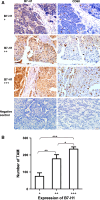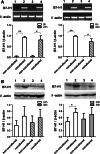Upregulation of B7-H1 expression is associated with macrophage infiltration in hepatocellular carcinomas
- PMID: 21853301
- PMCID: PMC11028743
- DOI: 10.1007/s00262-011-1094-3
Upregulation of B7-H1 expression is associated with macrophage infiltration in hepatocellular carcinomas
Abstract
The overexpression of B7-H1 in hepatocellular carcinoma (HCC) mediates HCC immune escape and obstructs the immunotherapy based on tumor-specific CD8+ T cells. Tumor-associated macrophages (TAM) are a major component of cancer-related inflammation and play a central role in tumor promotion. To classify the mechanism underlying the overexpression of B7-H1 in HCC, we examined B7-H1 expression and TAM infiltration in 63 cases of human HCC samples using immunohistochemistry method and found that B7-H1 overexpression was associated with TAM infiltration in HCC tissues. Furthermore, B7-H1 expression was upregulated at both mRNA level and protein level in HCC cells (BEL-7402 and SMMC-7721) cocultured with macrophages in a transwell system. The upregulation of B7-H1 expression induced by macrophage was inhibited by blocking NF-κB or STAT3 signal pathways. These results suggest that overexpression of B7-H1 in HCC may be induced by inflammatory microenvironment involving macrophages and imply that anti-inflammation therapy might be preventive for immune escape and assistant for immunotherapy of HCC.
Figures





Similar articles
-
Preferential Expression of Programmed Death Ligand 1 Protein in Tumor-Associated Macrophages and Its Potential Role in Immunotherapy for Hepatocellular Carcinoma.Int J Mol Sci. 2021 Apr 29;22(9):4710. doi: 10.3390/ijms22094710. Int J Mol Sci. 2021. PMID: 33946835 Free PMC article.
-
LncRNA MEG3 suppresses hepatocellular carcinoma by stimulating macrophage M1 polarization and modulating immune system via inhibiting CSF-1 in vivo/vitro studies.Int J Biol Macromol. 2024 Nov;281(Pt 3):136459. doi: 10.1016/j.ijbiomac.2024.136459. Epub 2024 Oct 11. Int J Biol Macromol. 2024. PMID: 39396590
-
IL-1β-Induced Elevation of Solute Carrier Family 7 Member 11 Promotes Hepatocellular Carcinoma Metastasis Through Up-regulating Programmed Death Ligand 1 and Colony-Stimulating Factor 1.Hepatology. 2021 Dec;74(6):3174-3193. doi: 10.1002/hep.32062. Epub 2021 Aug 27. Hepatology. 2021. PMID: 34288020
-
Immunotherapy for hepatocellular carcinoma.Cancer Lett. 2020 Feb 1;470:8-17. doi: 10.1016/j.canlet.2019.12.002. Epub 2019 Dec 4. Cancer Lett. 2020. PMID: 31811905 Review.
-
Individualized precision treatment: Targeting TAM in HCC.Cancer Lett. 2019 Aug 28;458:86-91. doi: 10.1016/j.canlet.2019.05.019. Epub 2019 May 24. Cancer Lett. 2019. PMID: 31129147 Review.
Cited by
-
Immunotherapy of hepatocellular carcinoma: Unique challenges and clinical opportunities.Oncoimmunology. 2012 Jan 1;1(1):48-55. doi: 10.4161/onci.1.1.18344. Oncoimmunology. 2012. PMID: 22720211 Free PMC article.
-
Tumor-Associated Macrophages in Hepatocellular Carcinoma: Friend or Foe?Gut Liver. 2021 Jul 15;15(4):500-516. doi: 10.5009/gnl20223. Gut Liver. 2021. PMID: 33087588 Free PMC article. Review.
-
Chemokines in progression, chemoresistance, diagnosis, and prognosis of colorectal cancer.Front Immunol. 2022 Jul 22;13:724139. doi: 10.3389/fimmu.2022.724139. eCollection 2022. Front Immunol. 2022. PMID: 35935996 Free PMC article. Review.
-
CD58 defines regulatory macrophages within the tumor microenvironment.Commun Biol. 2024 Aug 21;7(1):1025. doi: 10.1038/s42003-024-06712-6. Commun Biol. 2024. PMID: 39164573 Free PMC article.
-
Macrophage-derived CCL5 facilitates immune escape of colorectal cancer cells via the p65/STAT3-CSN5-PD-L1 pathway.Cell Death Differ. 2020 Jun;27(6):1765-1781. doi: 10.1038/s41418-019-0460-0. Epub 2019 Dec 4. Cell Death Differ. 2020. PMID: 31802034 Free PMC article.
References
-
- Hiroishi K, Eguchi J, Baba T, Shimazaki T, Ishii S, Hiraide A, Sakaki M, Doi H, Uozumi S, Omori R, Matsumura T, Yanagawa T, Ito T, Imawari M. Strong CD8(+) T-cell responses against tumor-associated antigens prolong the recurrence-free interval after tumor treatment in patients with hepatocellular carcinoma. J Gastroenterol. 2010;45(4):451–458. doi: 10.1007/s00535-009-0155-2. - DOI - PubMed
-
- Zhang HH, Mei MH, Fei R, Liao WJ, Wang XY, Qin LL, Wang JH, Wei L, Chen HS. Regulatory T cell depletion enhances tumor specific CD8 T-cell responses, elicited by tumor antigen NY-ESO-1b in hepatocellular carcinoma patients, in vitro. Int J Oncol. 2010;36(4):841–848. - PubMed
Publication types
MeSH terms
Substances
LinkOut - more resources
Full Text Sources
Other Literature Sources
Medical
Research Materials
Miscellaneous

